Sealing And Protecting Slate Shower Tiles

Slate Shower Sealing Tips
By Troy Cantini
Slate tile showers can have many problems and issues that are not present in most other types of tile showers. Slate is a natural stone that is formed from clay in sedimentary layers along riverbeds. There are many different types of slate depending on where in the world the slate is mined from. Some types of slate will hold up better than other types of slate in wet areas such as showers.
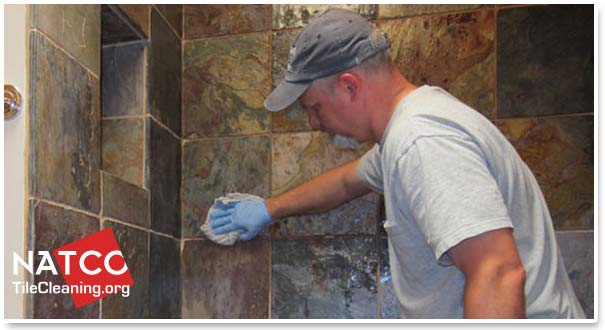
Regardless of the type of slate that is installed in a shower environment there is always the risk of the slate tiles becoming stained and damaged over time. The soft slate tiles can erode away over time and cause stains in the grout that are impossible to clean. The different layers of slate can also start flaking or chipping away. Sealing a slate tile shower is not a 100% solution to all these problems but is is helpful to keeping your slate shower looking good and functional for as long as possible.
When sealing a slate shower there are limitations and issues that are not present when sealing a slate tile floor. You should never try to use an enhancing sealer in a slate tile shower. The enhancing properties of the sealer can bleed away and cause splotchy areas in your shower and discolor the grout. Topical glossy or matte sealers should never be applied in a wet tile shower environment. These topical sealers can chip and flake away from the slate in a shower environment. Also both enhancing and topical sealers will not allow the slate shower to properly breath and water and mold can get trapped in the slate shower walls. This can also cause spalling and flaking away of slate tiles.
Before sealing a slate shower you should first clean it to remove as much dirt, mold and soap scum as possible. If a film of dirt and soap scum is present on the slate tiles then the sealer will not be effectively absorbed by the slate tiles. The slate tile shower should also be as dry as possible to allow the sealer to be completely absorbed by the slate.
The best sealer to use for sealing a slate tile shower is a high quality water based impregnating sealer. Slate tiles are extremely porous and need to be sealed with a quality sealer that has a large solids content. The large solids content of quality impregnating sealers will ensure that the sealer will effectively fill the voids in the porous slate stone. Cheap impregnating sealers will quickly become absorbed by the porous slate and their low solids content will do little to protect the slate. A quality water based impregnating sealer will protect the slate tiles while still allowing the slate to breath in its natural state. A properly breathing slate tile will evaporate water and water vapors from inside the stone. This ensures that the stone will get wet in the shower and dry between showers to exist in its natural most healthy state.

The most difficult aspect of sealing a slate shower is thoroughly saturating the slate tile shower walls with the impregnating sealer. The porous slate tiles need to be thoroughly saturated with sealer so it is best to use a cotton towel that is saturated with sealer for applying the sealer. You should saturate the towel with as much sealer as possible and wipe the slate tile shower walls with the saturated sealer towel.
Use the saturated sealer towel to continually apply the sealer to a slate tile shower wall for 5-10 minutes. Some of the sealer will probably drip down to the shower floor but this is to be expected when sealing a slate shower. You will also probably have to re-saturate your towel with sealer a few times while sealing the slate shower walls because the porous slate will absorb a lot of sealer. Continually apply the sealer to the entire slate tile shower wall and be careful to not allow the sealer to dry on the surface of the shower walls while your are sealing the slate.
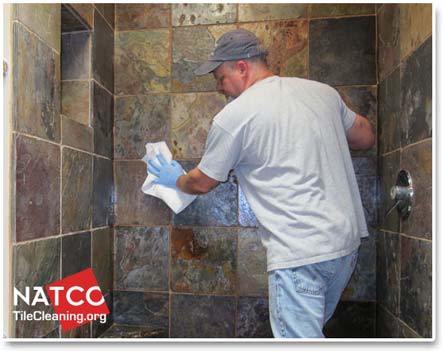
After you are done saturating the slate tile shower wall for the entire 5-10 minutes then it is important to wipe off all the excess sealer from the slate tile surfaces and the grout. You do not want the sealer to dry on the surface of the slate tiles or grout. The inherent porous nature of slate makes it unlikely that a sealer residue will be allowed to form on the surface of the slate tiles. You still do not want any pools of sealer to dry on the surface of the slate tiles or on the grout.
The easiest way to remove the excess sealer from the surface of the slate tiles is to use terry cloths or paper towels. Simply wipe the surface of the slate tiles with the absorbent paper towels or cotton cloth to remove any wet areas of sealer that are on the surface of the slate tiles and grout.
After you have sealed one wall of the slate tile shower then move on to seal the next adjoining shower wall. Continue the process until all of the vertical shower walls have been properly sealed. After you have sealed the vertical walls then the last area to be sealed will be the slate tile shower floor.
Sealing the slate tile shower floor should be the last area of the slate shower to be sealed. There will typically already be some sealer on the slate tile shower floor from sealing the slate shower walls. If the slate tile shower has a vinyl shower pan or is surrounding a bathtub then you only need to use paper towels to wipe up and remove all traces of excess sealer from these surfaces. When sealing a slate tile shower floor you can simply pour some sealer directly on the slate tile shower floor and use a towel to thoroughly saturate the slate tile shower floor with sealer. Allow the sealer to soak into the shower floor for 5-10 minutes and then remove the excess sealer with the terry towel or paper towels.
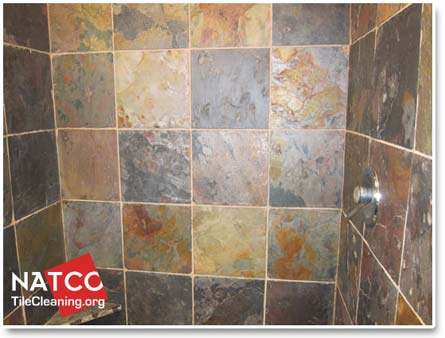
After you are done sealing the entire slate shower then you should inspect it for any areas of sealer haze on the slate tiles. If a sealer haze occurs it is because the sealer was allowed to dry on the surface of the slate tiles or grout. It is best to remove any sealer haze before it has a chance to set and dry for a long period of time. The easiest way to remove any sealer haze is to use some more sealer on a saturated towel to reactivate the sealer haze on the surface of the tiles. Then you can use a dry cotton towel or paper towels to wipe away the sealer haze.
NATCO Related Articles>
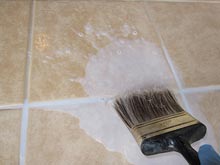 Glossy Sealer For Ceramic Tiles
Glossy Sealer For Ceramic Tiles
Sealing ceramic and porcelain tile floors with a glossy sealer can give the tiles and grout a glossy or matte sheen.
Read more»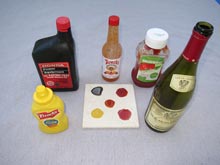 Stone Sealer Reviews
Stone Sealer Reviews
Stone sealers come in many formulas and they vary in how good they protect your natural stone tiles.
Read more»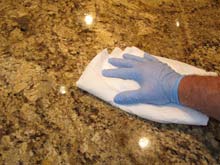 How To Seal Granite Countertop
How To Seal Granite Countertop
Sealing and preserving granite countertops is important for keeping them looking beautiful and stain free.
Read more»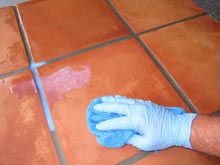 How To Seal Saltillo Tiles
How To Seal Saltillo Tiles
Due to Saltillo tiles being extremely porous it is best to seal them with a topical glossy sealer.
Read more»
